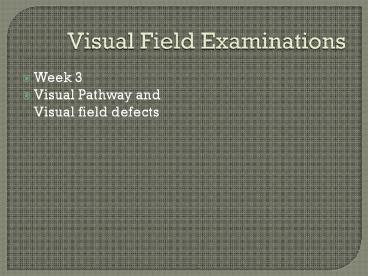Visual Field Examinations - PowerPoint PPT Presentation
Title:
Visual Field Examinations
Description:
Week 3 Visual Pathway and Visual field defects a= bjerrum area B=papillomacular bundle causing central and ceccocentral scotomas C=nasal bundle horazontal raphe wedge ... – PowerPoint PPT presentation
Number of Views:511
Avg rating:3.0/5.0
Title: Visual Field Examinations
1
Visual Field Examinations
- Week 3
- Visual Pathway and Visual field defects
2
4 major visual pathway zones
- Monocular retinal zone
- Nerve fiber/optic nerve zone
- Binocular chiasmal zone
- Post chiasmal zone
3
Monocular retinal zone
4
Retinal layer
- Field defects are found opposite in the VF to the
location of the damages in the eye.
5
Retinal layer
- Retinal detachment
- Visual field
6
Sub retinal layer
- Choroidal lesions care caused by tumors,
inflammations, infection, or fluid leaks. - This type of damage does not respect the
horizontal or vertical meridian.
7
Sub retinal layer
- Epi retinal membrane tear with bleeding
- hamangioblastoma
8
Rods and cones
- Damage may be caused by toxicity, inflammation,
infections or heredity.
9
Retinitis pigmentosa
- A diffuse pattern of field loss ( rod damage)
forming a ring a variable scotomas that will
expand outward toward the periphery and inward
toward the fovea until blindness results.
10
Macular pathology
- Damage to cone receptors causing damage to the
central 5 degrees. - Decreased color and VA will result.
11
Monocular retinal zoneCharacteristics
- Retinal layer
- Subretinal layer
- Rods and cones
- Retinitis pigmentosa
- Macular pathology
- All defects will be monocular.
- Most pathology will be visible with a scope.
- Lesions temporal to the fovea will present nasal
on VF. - Lesions can cross all meridians.
- Central scotomas will cause abnormal VA and color
vision.
12
Nerve fiber layer/optic nerve region zones
- Nerve fiber layer.
- Most common cause is glaucoma. Also may be caused
by trauma, blood vessel occlusions, infections,
inflammations and tumors
13
Papilledema
- (swelling of the disc)
- Produces a field loss by pushing the surrounding
retina out from the disc creating an enlarged
blind spot. - It will present more concentric than an enlarged
blind spot caused by glaucoma.
14
Nerve fiber defect patterns
- Macular and papillomacular defects create central
or ceccocentral scotomas
15
Bjerrum Defects
- Bjerrum area of nerve fiber layer.
- 15 degrees off fixation.
- Defect in this area will cause an arcing VF loss
opposite of the damage. - Will start small and increase in size over time.
16
Nerve fiber layer/optic nerve region
characteristics
- Nerve fiber layer
- Optic nerve (papilledema)
- Nerve fiber pattern defects
- Bjerrum area defects
- All defects are monocular.
- Defect will point to the disc since the nerve
fibers are traveling toward this point. - All pathology will be visible with a scope
17
Nerve fiber/optic nerve region
- Glaucomatous defects
- Damage to nerve fiber layer will show on VF.
18
Glaucoma
- Temporal wedge
- Nasal step
19
Nerve fiber/optic nerve region
- Optic nerve central scotoma
- Visual field
20
Optic nerve zone
21
Nerve fiber/ optic nerve region Characteristics
- All will be monocular only effecting the damaged
eye. - Damage to the nerve fiber layer will be caused by
glaucoma. - The VF will show up opposite of the damaged area.
- Specific areas of nerve fibers that have been
damaged will respect the horizontal meridian and
point in the direction of the disc. - Disc problems will be visible with a scope.
22
Binocular Chiasmal Zone
23
Binocular chiasmal zone
- Bi temporal VF loss characteristics
- Caused by pituitary tumors or swelling,
- Always bi temporal.
- Not visible with a scope.
- CT scan or MRI needed to show defect.
- Bilateral hemianopia (temporal).
- Will respect vertical meridian.
- Will start small and gradually increase in size.
24
Post chiasmal zone
25
Post chiasmal zone
- Lateral geniculate body
- Optic Radiations
26
Post chiasmal zone
- Not visible with a scope.
- Problem will be visible with CT or MRI scan.
- Homonymous defect will always be present. (Same
side) - Will start out small and gradually get larger.
- Will be hemianopic and will respect the vertical
meridian.
27
Lets see what you learned!
- Follow the pathway-
- Page 22 in your text.
- What is this problem?
28
What is the problem here?
29
Whats the problem here?
30
Last two, whats wrong?
31
Great job!
- See you next week for Goldmann Perimetry lecture.


















![State University of Performing and Visual Arts - [SUPVA], Rohtak PowerPoint PPT Presentation](https://s3.amazonaws.com/images.powershow.com/9656872.th0.jpg?_=202109050411)












